
Combo photo shows Lu Gaolin, Lu Dewen and workers sowing a cotton field on April 15, 2021 (top), an unmanned aerial vehicle (UAV) spraying farming chemicals over cotton fields on July 15, 2021 (middle), and a cotton picker harvesting cotton on Oct. 24, 2021, in Shawan City, northwest China's Xinjiang Uygur Autonomous Region. Lu Gaolin, a cotton farmer, is 56 years old and lives in Shawan City of Xinjiang Uygur Autonomous Region. The cotton harvest season in Xinjiang, China's largest cotton-producing region, will last until mid-November this year, with the output expected to reach 5.2 million tonnes. The region has contributed nearly 90 percent of China's cotton production capacity and about 20 percent of the global cotton production. In four days, Lu Gaolin completely finished harvesting his 64-hectare cotton field thanks to a gigantic green machine. The cotton picker is way more efficient than manual labor. "It used to take seven or eight workers over two months to complete the job of manually picking cotton," he said. Furthermore, new methods such as machine seeding and drone spraying have greatly improved farm work efficiency and quality. After this picking season, Lu and his son Dewen have bigger plans for the coming year. They intend to purchase a new cotton picker worth about 940,000 U.S. dollars together with other cotton farmers in order to increase their income. (Xinhua/Hu Huhu)

Combo photo shows Lu Gaolin, Lu Dewen and workers sowing a field with cotton on April 15, 2021 (top, photo taken with a drone), an unmanned aerial vehicle (UAV) spraying farming chemicals in cotton fields on July 15, 2021 (middle, photo taken with a drone), and a cotton picker harvesting cotton on Oct. 24, 2021 (below, photo taken with a drone), in Shawan City, northwest China's Xinjiang Uygur Autonomous Region. Lu Gaolin, a cotton farmer, is 56 years old and lives in Shawan City of Xinjiang Uygur Autonomous Region. The cotton harvest season in Xinjiang, China's largest cotton-producing region, will last until mid-November this year, with the output expected to reach 5.2 million tonnes. The region has contributed nearly 90 percent of China's cotton production capacity and about 20 percent of the global cotton production. In four days, Lu Gaolin completely finished harvesting his 64-hectare cotton field thanks to a gigantic green machine. The cotton picker is way more efficient than manual labor. "It used to take seven or eight workers over two months to complete the job of manually picking cotton," he said. Furthermore, new methods such as machine seeding and drone spraying have greatly improved farm work efficiency and quality. After this picking season, Lu and his son Dewen have bigger plans for the coming year. They intend to purchase a new cotton picker worth about 940,000 U.S. dollars together with other cotton farmers in order to increase their income. (Xinhua/Hu Huhu)

An unmanned aerial vehicle (UAV) is seen in Lu Gaolin's cotton fields in Shawan City, northwest China's Xinjiang Uygur Autonomous Region, July 15, 2021. The use of UAVs makes farming easier and improves efficiency. Lu Gaolin, a cotton farmer, is 56 years old and lives in Shawan City of Xinjiang Uygur Autonomous Region. The cotton harvest season in Xinjiang, China's largest cotton-producing region, will last until mid-November this year, with the output expected to reach 5.2 million tonnes. The region has contributed nearly 90 percent of China's cotton production capacity and about 20 percent of the global cotton production. In four days, Lu Gaolin completely finished harvesting his 64-hectare cotton field thanks to a gigantic green machine. The cotton picker is way more efficient than manual labor. "It used to take seven or eight workers over two months to complete the job of manually picking cotton," he said. Furthermore, new methods such as machine seeding and drone spraying have greatly improved farm work efficiency and quality. After this picking season, Lu and his son Dewen have bigger plans for the coming year. They intend to purchase a new cotton picker worth about 940,000 U.S. dollars together with other cotton farmers in order to increase their income. (Xinhua/Hu Huhu)

Lu Dewen, son of cotton farmer Lu Gaolin, shows previous task data of unmanned aerial vehicle (UAV) in Shawan City, northwest China's Xinjiang Uygur Autonomous Region, Oct. 19, 2021. The family bought an UAV this August to help spray defoliant. Lu Gaolin, a cotton farmer, is 56 years old and lives in Shawan City of Xinjiang Uygur Autonomous Region. The cotton harvest season in Xinjiang, China's largest cotton-producing region, will last until mid-November this year, with the output expected to reach 5.2 million tonnes. The region has contributed nearly 90 percent of China's cotton production capacity and about 20 percent of the global cotton production. In four days, Lu Gaolin completely finished harvesting his 64-hectare cotton field thanks to a gigantic green machine. The cotton picker is way more efficient than manual labor. "It used to take seven or eight workers over two months to complete the job of manually picking cotton," he said. Furthermore, new methods such as machine seeding and drone spraying have greatly improved farm work efficiency and quality. After this picking season, Lu and his son Dewen have bigger plans for the coming year. They intend to purchase a new cotton picker worth about 940,000 U.S. dollars together with other cotton farmers in order to increase their income. (Xinhua/Hu Huhu)

Lu Gaolin (R) talks with Wang Fuguang, head of an agricultural services team, about unmanned aerial vehicle in Shawan City, northwest China's Xinjiang Uygur Autonomous Region, July 15, 2021. Lu Gaolin, a cotton farmer, is 56 years old and lives in Shawan City of Xinjiang Uygur Autonomous Region. The cotton harvest season in Xinjiang, China's largest cotton-producing region, will last until mid-November this year, with the output expected to reach 5.2 million tonnes. The region has contributed nearly 90 percent of China's cotton production capacity and about 20 percent of the global cotton production. In four days, Lu Gaolin completely finished harvesting his 64-hectare cotton field thanks to a gigantic green machine. The cotton picker is way more efficient than manual labor. "It used to take seven or eight workers over two months to complete the job of manually picking cotton," he said. Furthermore, new methods such as machine seeding and drone spraying have greatly improved farm work efficiency and quality. After this picking season, Lu and his son Dewen have bigger plans for the coming year. They intend to purchase a new cotton picker worth about 940,000 U.S. dollars together with other cotton farmers in order to increase their income. (Xinhua/Hu Huhu)

Combo photo shows cottons in Lu Gaolin's cotton fields on July 15, 2021 (top) and on Oct. 19, 2021, respectively, in Shawan City, northwest China's Xinjiang Uygur Autonomous Region. Lu Gaolin, a cotton farmer, is 56 years old and lives in Shawan City of Xinjiang Uygur Autonomous Region. The cotton harvest season in Xinjiang, China's largest cotton-producing region, will last until mid-November this year, with the output expected to reach 5.2 million tonnes. The region has contributed nearly 90 percent of China's cotton production capacity and about 20 percent of the global cotton production. In four days, Lu Gaolin completely finished harvesting his 64-hectare cotton field thanks to a gigantic green machine. The cotton picker is way more efficient than manual labor. "It used to take seven or eight workers over two months to complete the job of manually picking cotton," he said. Furthermore, new methods such as machine seeding and drone spraying have greatly improved farm work efficiency and quality. After this picking season, Lu and his son Dewen have bigger plans for the coming year. They intend to purchase a new cotton picker worth about 940,000 U.S. dollars together with other cotton farmers in order to increase their income. (Xinhua/Hu Huhu)
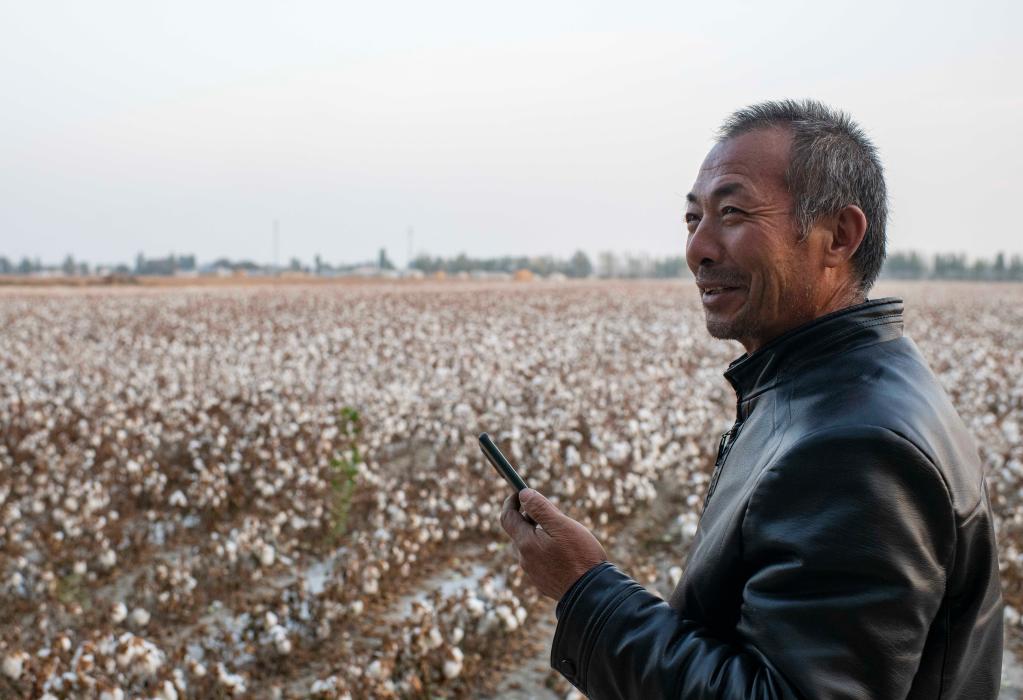
Lu Gaolin talks with a cotton picker owner on cellphone in Shawan City, northwest China's Xinjiang Uygur Autonomous Region, Oct. 19, 2021. During the peak season of harvesting, it took Lu Gaolin over a week to find and rent a cotton picker. Lu Gaolin, a cotton farmer, is 56 years old and lives in Shawan City of Xinjiang Uygur Autonomous Region. The cotton harvest season in Xinjiang, China's largest cotton-producing region, will last until mid-November this year, with the output expected to reach 5.2 million tonnes. The region has contributed nearly 90 percent of China's cotton production capacity and about 20 percent of the global cotton production. In four days, Lu Gaolin completely finished harvesting his 64-hectare cotton field thanks to a gigantic green machine. The cotton picker is way more efficient than manual labor. "It used to take seven or eight workers over two months to complete the job of manually picking cotton," he said. Furthermore, new methods such as machine seeding and drone spraying have greatly improved farm work efficiency and quality. After this picking season, Lu and his son Dewen have bigger plans for the coming year. They intend to purchase a new cotton picker worth about 940,000 U.S. dollars together with other cotton farmers in order to increase their income. (Xinhua/Hu Huhu)
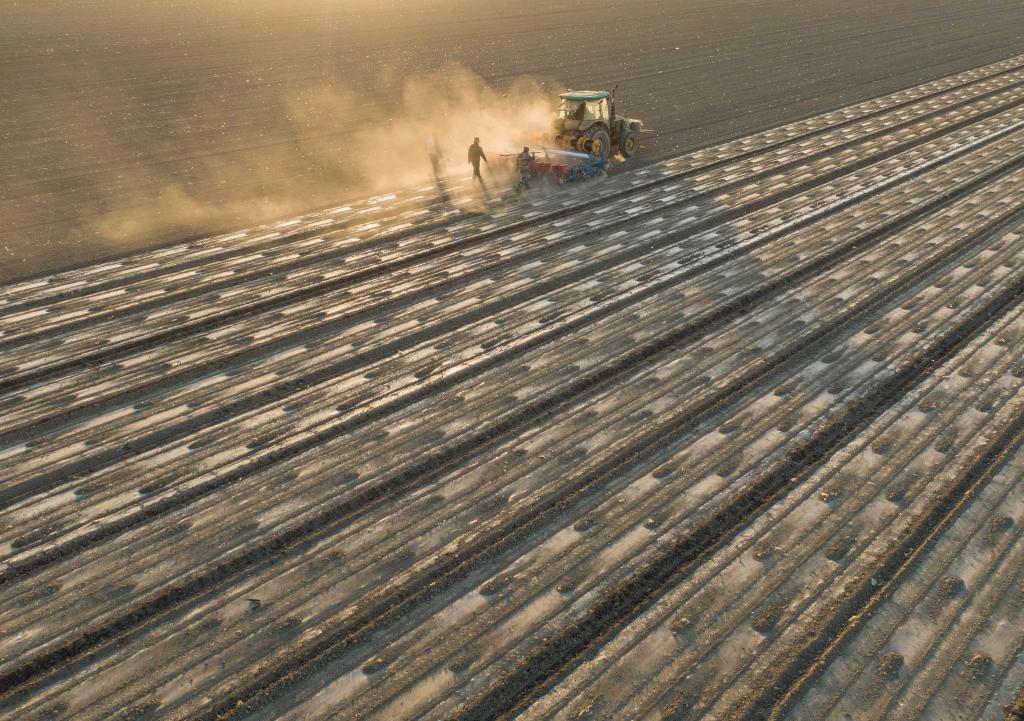
Aerial photo taken on April 15, 2021 shows Lu Gaolin, Lu Dewen and workers sowing a cotton field in Shawan City, northwest China's Xinjiang Uygur Autonomous Region. Lu Gaolin, a cotton farmer, is 56 years old and lives in Shawan City of Xinjiang Uygur Autonomous Region. The cotton harvest season in Xinjiang, China's largest cotton-producing region, will last until mid-November this year, with the output expected to reach 5.2 million tonnes. The region has contributed nearly 90 percent of China's cotton production capacity and about 20 percent of the global cotton production. In four days, Lu Gaolin completely finished harvesting his 64-hectare cotton field thanks to a gigantic green machine. The cotton picker is way more efficient than manual labor. "It used to take seven or eight workers over two months to complete the job of manually picking cotton," he said. Furthermore, new methods such as machine seeding and drone spraying have greatly improved farm work efficiency and quality. After this picking season, Lu and his son Dewen have bigger plans for the coming year. They intend to purchase a new cotton picker worth about 940,000 U.S. dollars together with other cotton farmers in order to increase their income. (Xinhua/Hu Huhu)
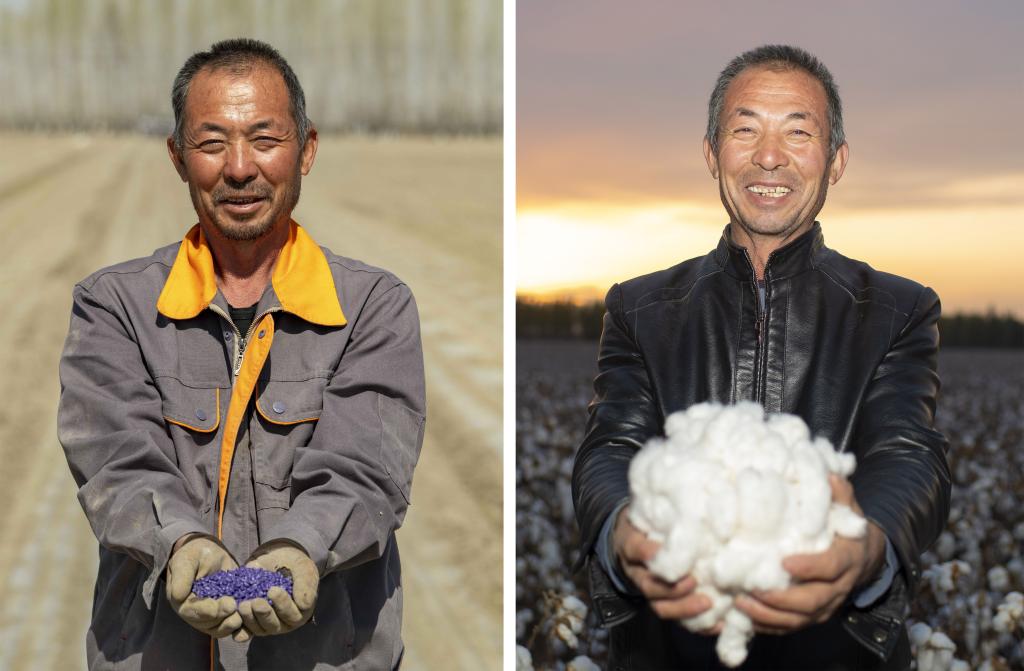
Combo photo taken in Lu Gaolin's cotton field shows Lu holding cotton seeds on April 15, 2021 (L), and Lu holding cotton amid the harvesting season on Oct. 23, 2021, in Shawan City, northwest China's Xinjiang Uygur Autonomous Region. Lu Gaolin, a cotton farmer, is 56 years old and lives in Shawan City of Xinjiang Uygur Autonomous Region. The cotton harvest season in Xinjiang, China's largest cotton-producing region, will last until mid-November this year, with the output expected to reach 5.2 million tonnes. The region has contributed nearly 90 percent of China's cotton production capacity and about 20 percent of the global cotton production. In four days, Lu Gaolin completely finished harvesting his 64-hectare cotton field thanks to a gigantic green machine. The cotton picker is way more efficient than manual labor. "It used to take seven or eight workers over two months to complete the job of manually picking cotton," he said. Furthermore, new methods such as machine seeding and drone spraying have greatly improved farm work efficiency and quality. After this picking season, Lu and his son Dewen have bigger plans for the coming year. They intend to purchase a new cotton picker worth about 940,000 U.S. dollars together with other cotton farmers in order to increase their income. (Xinhua/Hu Huhu)

Lu Gaolin (R) talks with a cotton picker owner about harvesting progress in Shawan City, northwest China's Xinjiang Uygur Autonomous Region, Oct. 22, 2021. Lu Gaolin, a cotton farmer, is 56 years old and lives in Shawan City of Xinjiang Uygur Autonomous Region. The cotton harvest season in Xinjiang, China's largest cotton-producing region, will last until mid-November this year, with the output expected to reach 5.2 million tonnes. The region has contributed nearly 90 percent of China's cotton production capacity and about 20 percent of the global cotton production. In four days, Lu Gaolin completely finished harvesting his 64-hectare cotton field thanks to a gigantic green machine. The cotton picker is way more efficient than manual labor. "It used to take seven or eight workers over two months to complete the job of manually picking cotton," he said. Furthermore, new methods such as machine seeding and drone spraying have greatly improved farm work efficiency and quality. After this picking season, Lu and his son Dewen have bigger plans for the coming year. They intend to purchase a new cotton picker worth about 940,000 U.S. dollars together with other cotton farmers in order to increase their income. (Xinhua/Hu Huhu)
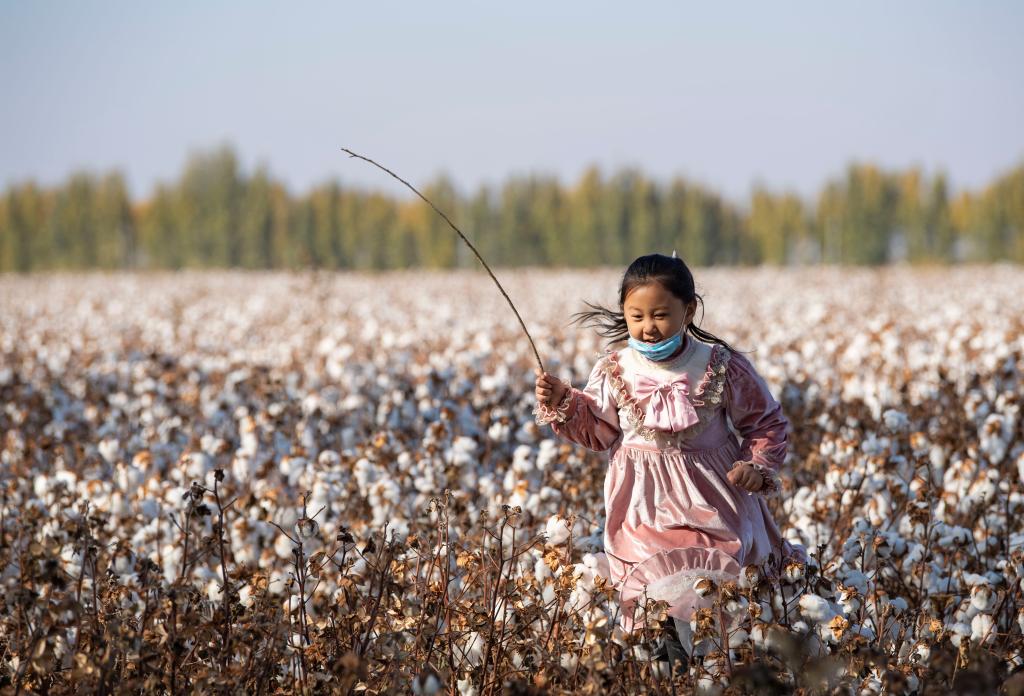
Lu Gaolin's granddaughter is seen running in a cotton field in Shawan City, northwest China's Xinjiang Uygur Autonomous Region, Oct. 24, 2021. Lu Gaolin, a cotton farmer, is 56 years old and lives in Shawan City of Xinjiang Uygur Autonomous Region. The cotton harvest season in Xinjiang, China's largest cotton-producing region, will last until mid-November this year, with the output expected to reach 5.2 million tonnes. The region has contributed nearly 90 percent of China's cotton production capacity and about 20 percent of the global cotton production. In four days, Lu Gaolin completely finished harvesting his 64-hectare cotton field thanks to a gigantic green machine. The cotton picker is way more efficient than manual labor. "It used to take seven or eight workers over two months to complete the job of manually picking cotton," he said. Furthermore, new methods such as machine seeding and drone spraying have greatly improved farm work efficiency and quality. After this picking season, Lu and his son Dewen have bigger plans for the coming year. They intend to purchase a new cotton picker worth about 940,000 U.S. dollars together with other cotton farmers in order to increase their income. (Xinhua/Hu Huhu)

Lu Gaolin bites cotton seeds to check the conditions of cotton to be harvested after rain in Shawan City, northwest China's Xinjiang Uygur Autonomous Region, Oct. 23, 2021. Lu Gaolin, a cotton farmer, is 56 years old and lives in Shawan City of Xinjiang Uygur Autonomous Region. The cotton harvest season in Xinjiang, China's largest cotton-producing region, will last until mid-November this year, with the output expected to reach 5.2 million tonnes. The region has contributed nearly 90 percent of China's cotton production capacity and about 20 percent of the global cotton production. In four days, Lu Gaolin completely finished harvesting his 64-hectare cotton field thanks to a gigantic green machine. The cotton picker is way more efficient than manual labor. "It used to take seven or eight workers over two months to complete the job of manually picking cotton," he said. Furthermore, new methods such as machine seeding and drone spraying have greatly improved farm work efficiency and quality. After this picking season, Lu and his son Dewen have bigger plans for the coming year. They intend to purchase a new cotton picker worth about 940,000 U.S. dollars together with other cotton farmers in order to increase their income. (Xinhua/Hu Huhu)

Aerial photo taken on Oct. 24, 2021 shows a cotton picker rented by Lu Gaolin harvesting in fields in Shawan City, northwest China's Xinjiang Uygur Autonomous Region. Lu Gaolin, a cotton farmer, is 56 years old and lives in Shawan City of Xinjiang Uygur Autonomous Region. The cotton harvest season in Xinjiang, China's largest cotton-producing region, will last until mid-November this year, with the output expected to reach 5.2 million tonnes. The region has contributed nearly 90 percent of China's cotton production capacity and about 20 percent of the global cotton production. In four days, Lu Gaolin completely finished harvesting his 64-hectare cotton field thanks to a gigantic green machine. The cotton picker is way more efficient than manual labor. "It used to take seven or eight workers over two months to complete the job of manually picking cotton," he said. Furthermore, new methods such as machine seeding and drone spraying have greatly improved farm work efficiency and quality. After this picking season, Lu and his son Dewen have bigger plans for the coming year. They intend to purchase a new cotton picker worth about 940,000 U.S. dollars together with other cotton farmers in order to increase their income. (Xinhua/Hu Huhu)

Lu Gaolin holds his granddaughter who came to the countryside over the weekends in Shawan City, northwest China's Xinjiang Uygur Autonomous Region, Oct. 24, 2021. Lu Gaolin, a cotton farmer, is 56 years old and lives in Shawan City of Xinjiang Uygur Autonomous Region. The cotton harvest season in Xinjiang, China's largest cotton-producing region, will last until mid-November this year, with the output expected to reach 5.2 million tonnes. The region has contributed nearly 90 percent of China's cotton production capacity and about 20 percent of the global cotton production. In four days, Lu Gaolin completely finished harvesting his 64-hectare cotton field thanks to a gigantic green machine. The cotton picker is way more efficient than manual labor. "It used to take seven or eight workers over two months to complete the job of manually picking cotton," he said. Furthermore, new methods such as machine seeding and drone spraying have greatly improved farm work efficiency and quality. After this picking season, Lu and his son Dewen have bigger plans for the coming year. They intend to purchase a new cotton picker worth about 940,000 U.S. dollars together with other cotton farmers in order to increase their income. (Xinhua/Hu Huhu)
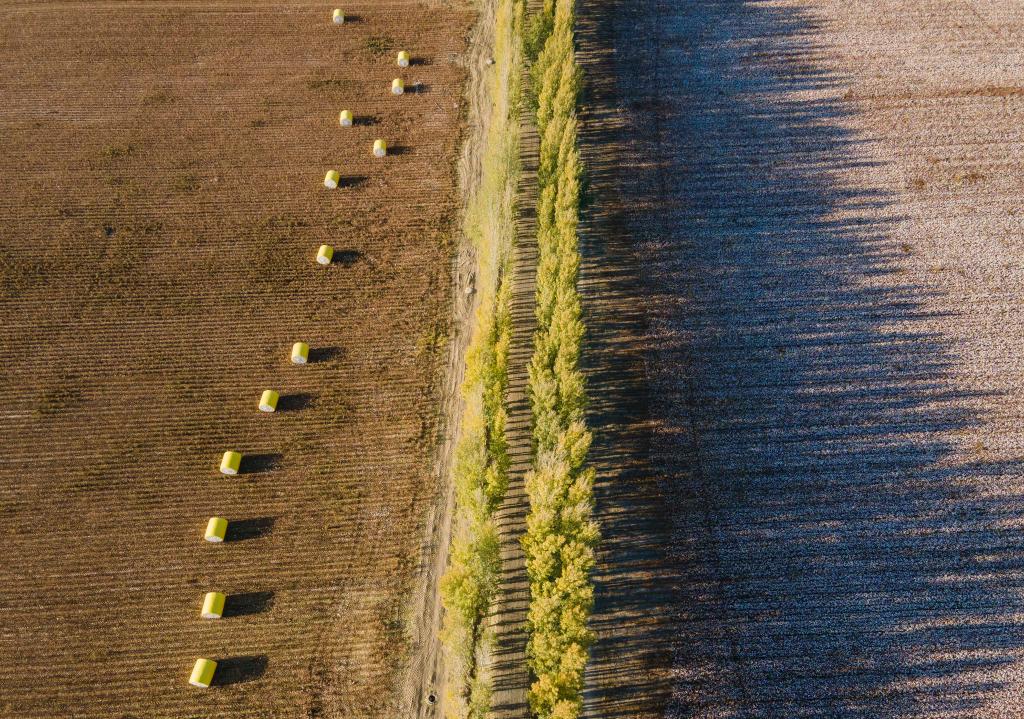
Aerial photo taken above Lu Gaolin's cotton fields on Oct. 24, 2021 shows harvested packed cotton on the left field, and cotton to be harvested on the right field in Shawan City, northwest China's Xinjiang Uygur Autonomous Region. Lu Gaolin, a cotton farmer, is 56 years old and lives in Shawan City of Xinjiang Uygur Autonomous Region. The cotton harvest season in Xinjiang, China's largest cotton-producing region, will last until mid-November this year, with the output expected to reach 5.2 million tonnes. The region has contributed nearly 90 percent of China's cotton production capacity and about 20 percent of the global cotton production. In four days, Lu Gaolin completely finished harvesting his 64-hectare cotton field thanks to a gigantic green machine. The cotton picker is way more efficient than manual labor. "It used to take seven or eight workers over two months to complete the job of manually picking cotton," he said. Furthermore, new methods such as machine seeding and drone spraying have greatly improved farm work efficiency and quality. After this picking season, Lu and his son Dewen have bigger plans for the coming year. They intend to purchase a new cotton picker worth about 940,000 U.S. dollars together with other cotton farmers in order to increase their income. (Xinhua/Hu Huhu)

Combo photo shows Lu Gaolin driving his vehicle loaded with farming implements to cottons fields for farming (top, photo taken on April 15, 2021) and Lu Gaolin waiting for a cotton picker in his newly-purchased off-road vehicle (bottom, photo taken on Oct. 22, 2021), in Shawan City, northwest China's Xinjiang Uygur Autonomous Region. Lu Gaolin, a cotton farmer, is 56 years old and lives in Shawan City of Xinjiang Uygur Autonomous Region. The cotton harvest season in Xinjiang, China's largest cotton-producing region, will last until mid-November this year, with the output expected to reach 5.2 million tonnes. The region has contributed nearly 90 percent of China's cotton production capacity and about 20 percent of the global cotton production. In four days, Lu Gaolin completely finished harvesting his 64-hectare cotton field thanks to a gigantic green machine. The cotton picker is way more efficient than manual labor. "It used to take seven or eight workers over two months to complete the job of manually picking cotton," he said. Furthermore, new methods such as machine seeding and drone spraying have greatly improved farm work efficiency and quality. After this picking season, Lu and his son Dewen have bigger plans for the coming year. They intend to purchase a new cotton picker worth about 940,000 U.S. dollars together with other cotton farmers in order to increase their income. (Xinhua/Hu Huhu)

Lu Gaolin (R) and his son Lu Dewen check the humidity of cotton in Shawan City, northwest China's Xinjiang Uygur Autonomous Region, Oct. 23, 2021. Lu Gaolin, a cotton farmer, is 56 years old and lives in Shawan City of Xinjiang Uygur Autonomous Region. The cotton harvest season in Xinjiang, China's largest cotton-producing region, will last until mid-November this year, with the output expected to reach 5.2 million tonnes. The region has contributed nearly 90 percent of China's cotton production capacity and about 20 percent of the global cotton production. In four days, Lu Gaolin completely finished harvesting his 64-hectare cotton field thanks to a gigantic green machine. The cotton picker is way more efficient than manual labor. "It used to take seven or eight workers over two months to complete the job of manually picking cotton," he said. Furthermore, new methods such as machine seeding and drone spraying have greatly improved farm work efficiency and quality. After this picking season, Lu and his son Dewen have bigger plans for the coming year. They intend to purchase a new cotton picker worth about 940,000 U.S. dollars together with other cotton farmers in order to increase their income. (Xinhua/Hu Huhu)
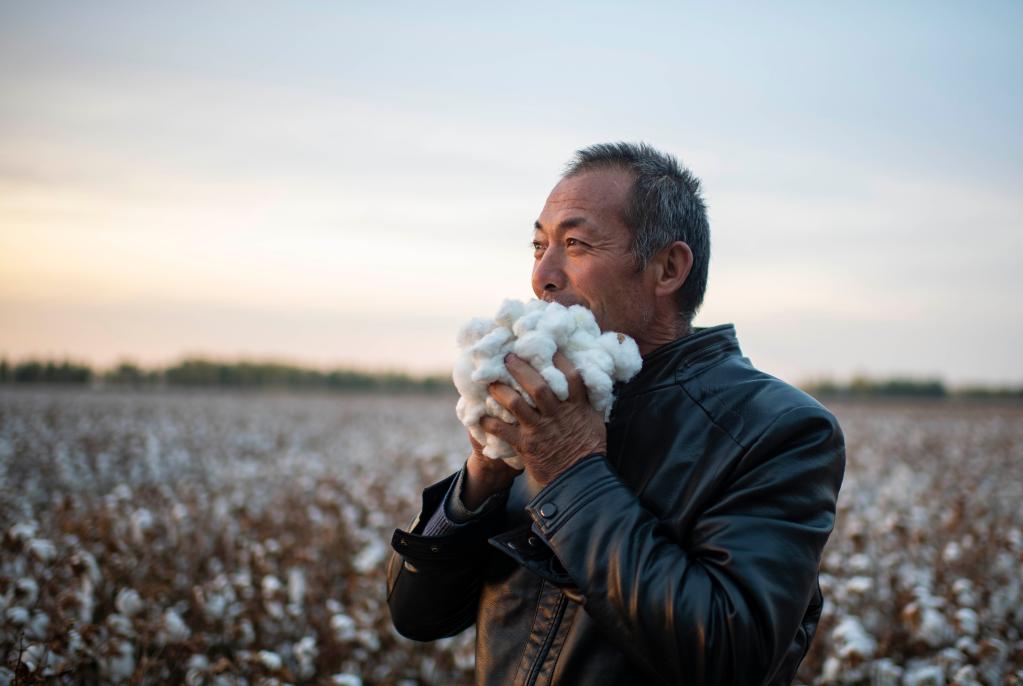
Lu Gaolin holds cotton to his face to check crop quality in Shawan City, northwest China's Xinjiang Uygur Autonomous Region, Oct. 23, 2021. Lu Gaolin, a cotton farmer, is 56 years old and lives in Shawan City of Xinjiang Uygur Autonomous Region. The cotton harvest season in Xinjiang, China's largest cotton-producing region, will last until mid-November this year, with the output expected to reach 5.2 million tonnes. The region has contributed nearly 90 percent of China's cotton production capacity and about 20 percent of the global cotton production. In four days, Lu Gaolin completely finished harvesting his 64-hectare cotton field thanks to a gigantic green machine. The cotton picker is way more efficient than manual labor. "It used to take seven or eight workers over two months to complete the job of manually picking cotton," he said. Furthermore, new methods such as machine seeding and drone spraying have greatly improved farm work efficiency and quality. After this picking season, Lu and his son Dewen have bigger plans for the coming year. They intend to purchase a new cotton picker worth about 940,000 U.S. dollars together with other cotton farmers in order to increase their income. (Xinhua/Hu Huhu)
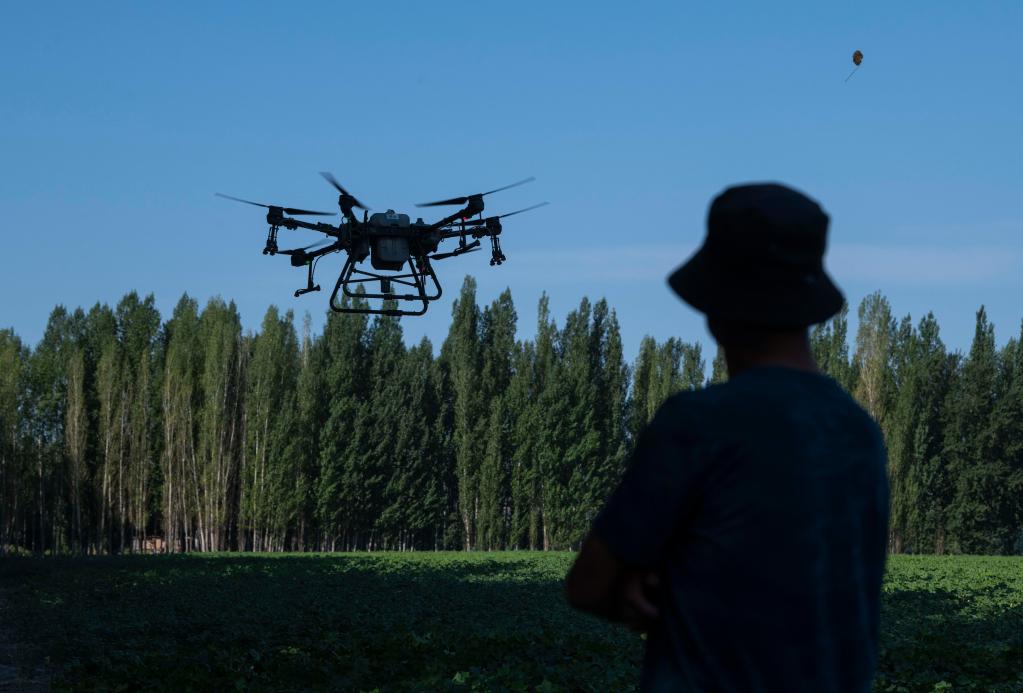
Lu Gaolin watches an unmanned aerial vehicle (UAV) spraying farming chemicals in cotton fields in Shawan City, northwest China's Xinjiang Uygur Autonomous Region, July 15, 2021. Instead of applying farming chemicals using tractors, as was usually done, Lu Gaolin and his families hired a team using UAVs to finish the job this year. Lu Gaolin, a cotton farmer, is 56 years old and lives in Shawan City of Xinjiang Uygur Autonomous Region. The cotton harvest season in Xinjiang, China's largest cotton-producing region, will last until mid-November this year, with the output expected to reach 5.2 million tonnes. The region has contributed nearly 90 percent of China's cotton production capacity and about 20 percent of the global cotton production. In four days, Lu Gaolin completely finished harvesting his 64-hectare cotton field thanks to a gigantic green machine. The cotton picker is way more efficient than manual labor. "It used to take seven or eight workers over two months to complete the job of manually picking cotton," he said. Furthermore, new methods such as machine seeding and drone spraying have greatly improved farm work efficiency and quality. After this picking season, Lu and his son Dewen have bigger plans for the coming year. They intend to purchase a new cotton picker worth about 940,000 U.S. dollars together with other cotton farmers in order to increase their income. (Xinhua/Hu Huhu)
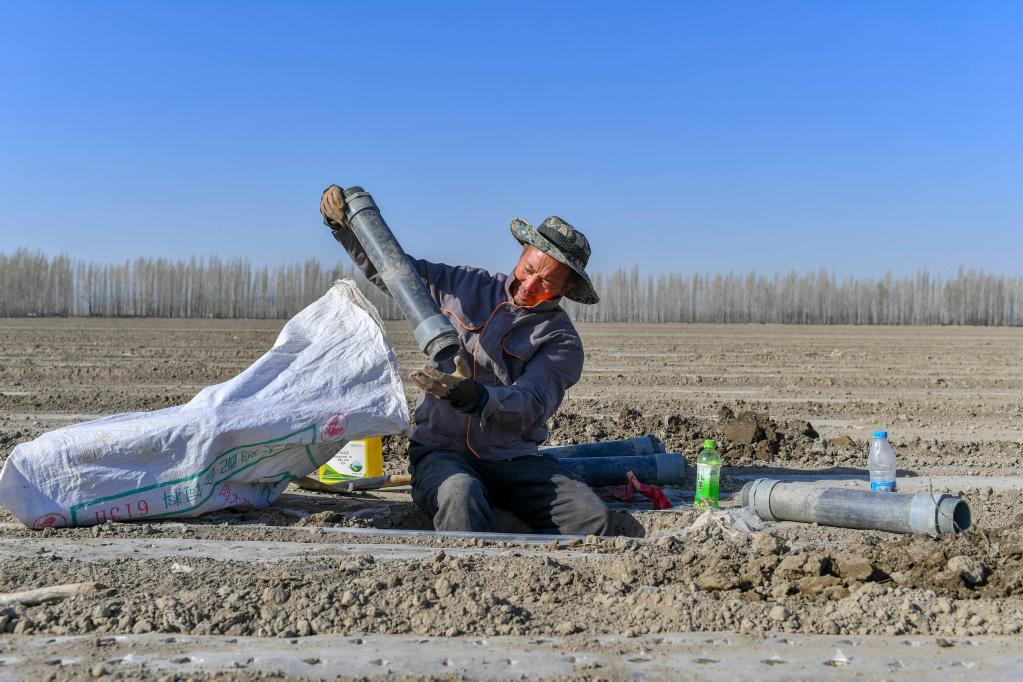
Lu Gaolin prepares irrigation equipment in the cotton fields in Shawan City, northwest China's Xinjiang Uygur Autonomous Region, April 15, 2021. Lu Gaolin, a cotton farmer, is 56 years old and lives in Shawan City of Xinjiang Uygur Autonomous Region. The cotton harvest season in Xinjiang, China's largest cotton-producing region, will last until mid-November this year, with the output expected to reach 5.2 million tonnes. The region has contributed nearly 90 percent of China's cotton production capacity and about 20 percent of the global cotton production. In four days, Lu Gaolin completely finished harvesting his 64-hectare cotton field thanks to a gigantic green machine. The cotton picker is way more efficient than manual labor. "It used to take seven or eight workers over two months to complete the job of manually picking cotton," he said. Furthermore, new methods such as machine seeding and drone spraying have greatly improved farm work efficiency and quality. After this picking season, Lu and his son Dewen have bigger plans for the coming year. They intend to purchase a new cotton picker worth about 940,000 U.S. dollars together with other cotton farmers in order to increase their income. (Xinhua/Hu Huhu)
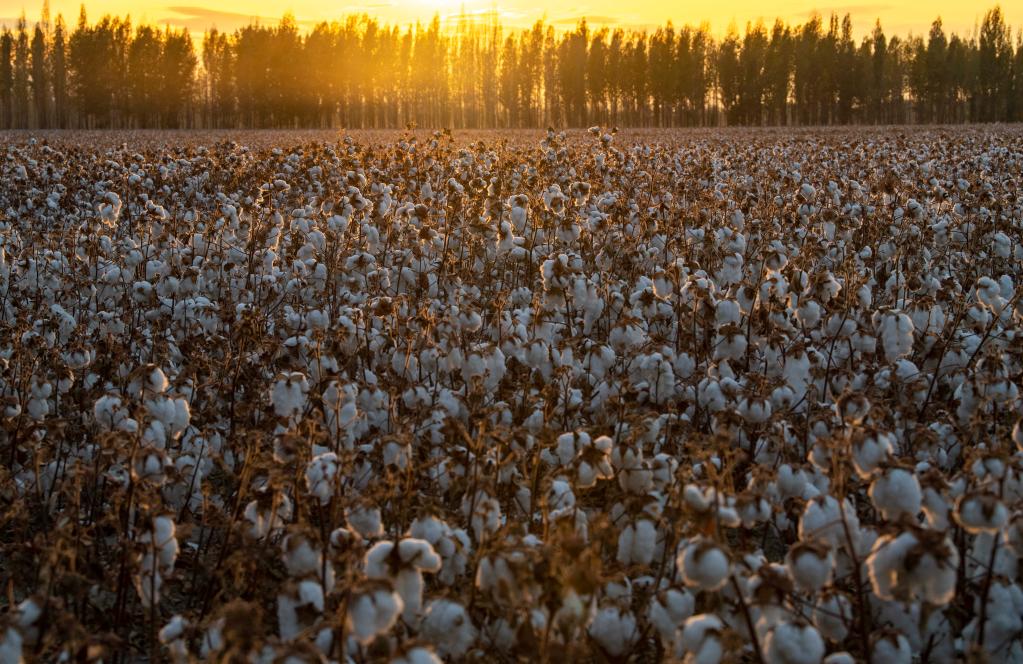
Photo taken on Oct. 23, 2021 shows cotton to be harvested in Lu Gaolin's fields in Shawan City, northwest China's Xinjiang Uygur Autonomous Region. Lu Gaolin, a cotton farmer, is 56 years old and lives in Shawan City of Xinjiang Uygur Autonomous Region. The cotton harvest season in Xinjiang, China's largest cotton-producing region, will last until mid-November this year, with the output expected to reach 5.2 million tonnes. The region has contributed nearly 90 percent of China's cotton production capacity and about 20 percent of the global cotton production. In four days, Lu Gaolin completely finished harvesting his 64-hectare cotton field thanks to a gigantic green machine. The cotton picker is way more efficient than manual labor. "It used to take seven or eight workers over two months to complete the job of manually picking cotton," he said. Furthermore, new methods such as machine seeding and drone spraying have greatly improved farm work efficiency and quality. After this picking season, Lu and his son Dewen have bigger plans for the coming year. They intend to purchase a new cotton picker worth about 940,000 U.S. dollars together with other cotton farmers in order to increase their income. (Xinhua/Hu Huhu)








